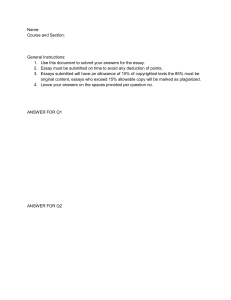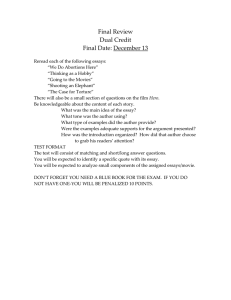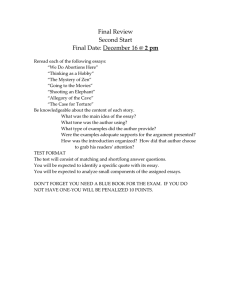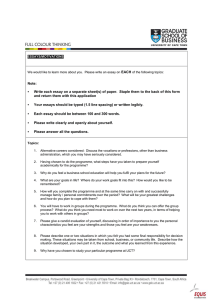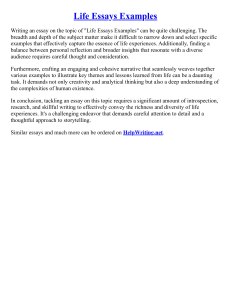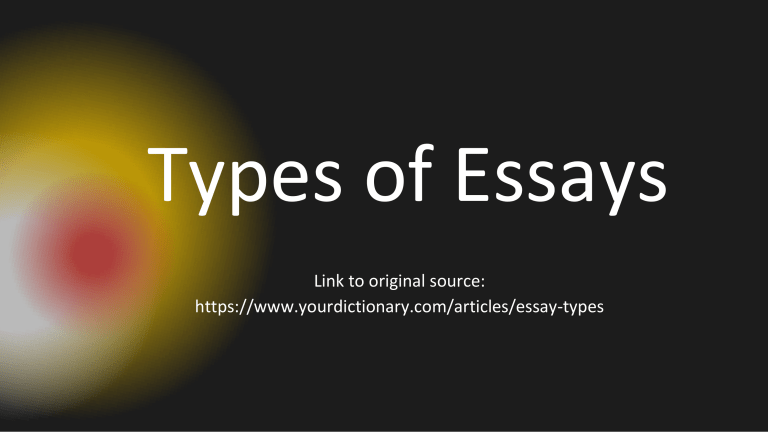
Types of Essays Link to original source: https://www.yourdictionary.com/articles/essay-types 1. Narrative Essays Narrative essays tell stories from your life or the lives of others. They’re told just like fictional short stories, with all the story elements characters, a setting, a compelling plot, a climax, and a resolution. Narrative essays use the third-person perspective (it happened to someone else) or the first-person perspective (it happened to the writer). Narrative essays should be entertaining and engaging to read, so choose a narrative writing topic that speaks to you. Narrative Essay Example Structure When writing a narrative essay, a possible structure could include: • Introduction - Hint at what you or the character learned • Body - Tell the story from beginning to end, finishing in an exciting or compelling climax in the last body paragraph • Conclusion - Reflect on what you or the character learned from the experience in the story 2. Argumentative Essays Argumentative essays (also called argument essays) investigate topics fairly and thoroughly to present the writer’s argument to the reader. The writer makes a claim and argues why evidence and logic support that claim in a well-structured essay. Strong argumentative essays use rhetorical devices to strengthen their arguments, and they address the opposing argument (known as a counterclaim) as well. When choosing an argumentative essay topic, select an issue that you care about (or a topic you’d like to learn more about), and begin researching your position with reliable sources. Argumentative Essay Structure Example You can structure an argumentative essay like this: • Introduction - Introduce the topic and your claim in a thesis statement • Body - Support your position with evidence (and bring up counterclaims) • Conclusion - Restate your claim and summarize how you proved it 3. Expository Essays Expository essays use research and critical thinking to explain more about a topic. Newspaper articles are a type of expository essay — they provide information to the reader in a concise, factual way. Writing expository essays requires a straightforward outline, evidence-based conclusions, and a strong thesis statement. Though expository writing reveals information, it’s not the same as technical writing. Expository essays “expose” the truth about a selected topic, not just the information about it. Expository Essay Structure Example Most expository essays follow a structure similar to this: • Introduction - Introduce the topic and hint at a deeper truth • Body - Explain more about the topic with evidence; expose the truth and/or implications of the topic in a final body paragraph • Conclusion - Summarize the information and its larger meaning 4. Descriptive Essays Like narrative essays, descriptive essays use narration to set a scene for the reader. But unlike narrative essays, descriptive essays don’t tell a story from beginning to end. If a painting could be an essay, it would be a descriptive essay — a written experience that you can almost see. Descriptive essays use lots of sensory details to describe the way something looks, sounds, smells, tastes, or feels. Well-written descriptive essays also use similes, metaphors, hyperboles, or other types of figurative language to pull their readers into the experience. Descriptive Essay Structure Example When writing a descriptive essay, you can follow this outline: • Introduction - Introduce the topic you’re going to describe with an engaging, sensory hook sentence • Body - Describe the topic with rich sensory detail and figurative language • Conclusion - Summarize your essay and conclude with a memorable descriptive sentence 5. Persuasive Essays Persuasive essay writers try to convince their readers to agree with them. You’ll find examples of persuasive writing in both essays and speeches when a speaker, writer, or politician wants the audience on their side. When you write a persuasive essay, you use similar strategies as you would in an argumentative essay. But persuasive essays use personal anecdotes (stories about yourself or others) and emotional appeals rather than the logic and evidence you’ll find in an argumentative essay. They also include a call to action at the end that inspires their audience to act. Persuasive Essay Structure Example You can structure your persuasive essay in a similar way as your argumentative essay, with a few key differences. • Introduction - Use an emotional evocative hook to get the reader interested in your position right away • Body - Use personal anecdotes, dramatic language, and emotional appeals to get the reader on your side • Conclusion - Finish with a call to action for your reader — what should they do now? 6. Informative Essays Like expository essays, informative essays (also called informational essays) inform their readers about a topic. But the main purpose of an informative essay is to educate the audience rather than to expose them to the truth. Informative essays require lots of evidence and strong research. Be sure to choose an informative essay topic that interests you, since you’re going to learn a lot about it during the course of your writing. Informative Essay Structure Example Outline your informative essay structure in a straightforward, nononsense way. • Introduction - Introduce the topic with a strong hook (such as an interesting fact or statistic) • Body - Explain more about the topic with evidence • Conclusion - Restate your thesis and conclude with a general statement about the topic 7. Personal Narrative Essays Personal narrative essays (also called personal narratives) are a form of narrative writing in which the writer explores how an experience affected or shaped them. They focus on a single event or theme in one’s life, and unlike narrative essays, personal narratives are always true (and always autobiographical). College entrance essays are a type of personal narrative in which a college applicant considers how an event or person in their past helped them to become the person they are today. Another type of personal narrative is a memoir — a longer narrative about one’s own life. Personal Narrative Structure Example It’s tempting to write a personal narrative in an unstructured way, but having a solid structure is the key to writing a compelling personal narrative. • Introduction - Set the scene, both in setting and tone (Where are we? When does it take place?) • Body - Tell the story with rich detail, beginning to end, culminating in a meaningful climax • Conclusion - Reflect on the experience and reveal how it shaped or changed you 8. Reflective Essays Reflective essays explore an idea, concept, or observation from a writer’s point of view. They may include humor or emotional writing, but they should reveal a lot about the writer themselves (and about the reader). Both reflective writing and personal narratives are forms of creative writing. But while reflective essays are personal, they don’t need to be written in a narrative format or tell a story. Think about a well-written journal entry — it probably doesn’t tell a story from start to finish, but explores the way something made the writer feel. Reflective Essay Structure Example Depending on your topic, reflective essays can be quite structured or more loosely organized. Generally, you can follow a standard format. • Introduction - Introduce the topic with detail and a thesis statement • Body - Reflect on the topic (also including detail) • Conclusion - Restate the thesis statement in a conclusion about the topic 9. Synthesis Essays Synthesis essays gather opinions, evidence, and proposals from various sources and present it to the reader as one document. They’re similar to argumentative essays (in that they present a claim) and informative essays (in that they present information), but the goal of a synthesis essay is first and foremost to compile a body of evidence. That evidence may support the writer’s claim, or it may cause them to reexamine their thoughts about the topic. Either way, synthesis essays include a wealth of sources (all of which must be properly cited, of course). Synthesis Essay Structure Example You can structure your synthesis essay like an expository essay. • Introduction - Hook the reader with a strong first sentence, then state your position in a thesis statement • Body - Support your thesis with the wealth of evidence you have gathered from different sources • Conclusion - Restate your thesis and summarize how you’ve supported your position 10. Definition Essays Definition essays define a term or idea. These terms could be vocabulary words, technical terms, abstract concepts, historical words, or any other idea that a writer wants to define for the reader. It seems like that may only get you a sentence or two, but a wellwritten definition essay does a lot more than look up word meanings. They can be expository when pointing out little-known facts or implications of the term, reflective when referring to important concepts, and even argumentative if the writer has a stance to defend. Definition Essay Structure Example Definition essays have straightforward outlines that make it easy for the reader to understand your meaning. • Introduction - State the word or concept you’re defining in the first sentence, and provide a general definition in the thesis • Body - Elaborate on the thesis statement with support, alternate definitions, and implications of the word or concept • Conclusion - Restate the definition along with the ways you elaborated on it 11. Analytical Essays Analytical essays analyze a topic with strong detail and critical thinking. Also known as critical analysis essays, they use a balanced approach to thoroughly analyze something, whether it’s a passage in a piece of writing (known as literary analysis or rhetorical analysis), a an element from a scientific discovery, or an important historical event. Like reflective writing, analytical writing is very detailed and focused on a single topic. While that topic may have larger implications in the essay (and it should), each sentence should connect back to the core of the analytical essay. Analytical Essay Structure Example Analytical essays should follow a strict outline that doesn’t detract from its thesis statement. • Introduction - Introduce the topic and refer to the levels of analysis you’ve done on it • Body - Start with your lowest level of analysis and build up to the highest level (preferably in your last body paragraph), tying everything back to the thesis • Conclusion - Restate your thesis and levels of analysis 12. Compare and Contrast Essays Compare and contrast essays are analytical essays that examine how two subjects are similar and different. These subjects can be two characters, two historical events, two concepts — any two topics that have similarities (compare) and differences (contrast). Compare and contrast essays often use expository writing to present the information in a thoughtful way. When writing a compare and contrast essay, structure can be just as important as the essay’s thesis statement. Structuring your compare and contrast essay can highlight the ways your topics resemble and differ from each other. Thanks to the many compare and contrast essay topics available, you’ll never run out of things to compare (or contrast). Compare and Contrast Example Compare and contrast essays rely on a tight structure to analyze topics — but that structure may differ, depending on your topics. • Introduction - Introduce the topic you’re comparing; find a creative and engaging way to state that they are similar but different in your thesis statement • Body - Either analyze each characteristic in a body paragraph (Characteristic 1 of Topic 1 is different from Characteristic 1 of Topic 2), or analyze one entire topic before comparing and contrasting it with the second entire topic (Here are Characteristics 1, 2, and 3 of Topic 1; now, here are Characteristics 1, 2, and 3 of Topic 2) • Conclusion - Restate your thesis and summarize your points Characteristic-by-Characteristic Analysis: • In this approach, you dedicate each body paragraph to analyzing one specific characteristic or aspect of the topics being compared. For example, you might have one paragraph comparing the appearance of Topic 1 with Topic 2, another paragraph comparing their functionality, and so on. Within each paragraph, you discuss how that particular characteristic differs or is similar between the two topics. Whole Topic Analysis: Alternatively, you can choose to analyze one entire topic before moving on to the next. This means that you would first discuss all the characteristics of Topic 1 in one or more paragraphs, and then follow it up with a separate discussion of all the characteristics of Topic 2. This approach allows for a more in-depth exploration of each topic before comparing and contrasting them directly. 13. Cause and Effect Essays Cause and effect essays, another type of analytical essay, use structure to show the relationship between an event and its consequences. These essays often explore historical events or plot points in a story, though cause and effect topics can vary by subject. Depending on how you write your cause and effect essay, you can use expository writing to explain how one thing led to another, or you can argue a little-known element of the cause and effect relationship (such as a surprising event, or a seemingly unrelated consequence). Cause and Effect Essay Structure Example Like compare and contrast essays, the structure of cause and effect essays depend on the topic you’re writing about and how you want to analyze it. • Introduction - Introduce the topic and make your claim about how the event caused the effects in your thesis statement • Body - Discuss the event in a paragraph before you discuss the effect, then defend your claim about how they’re related (or, you can spend the entire body section defending the claim, if that’s more reasonable for your topic) • Conclusion - Restate the thesis and assert how you’ve proven your claim about the relationship between the cause and effect 14. Evaluation Essays Evaluation essays use a measured, unbiased approach to evaluating a work, topic, product, or another subject. With sound evidence and reasoning, evaluation essays present the writer’s opinion about the subject. Movie reviews, book reviews, and sports columns are all types of evaluation essays. Though evaluation essays do thoroughly analyze their subject (think of the detail included in a movie review), they go beyond analysis. You would write an evaluation essay to present an educated and considered viewpoint, which should influence the reader when making up their own mind. Evaluation Essay Structure Example Your opinion is the claim in an evaluation essay, and just like any other claim, you need to defend it. • Introduction - Introduce what you’re evaluating and state your evaluation in the thesis statement • Body - Give an overview of what you’re evaluating (such as a summary), then defend your opinion with criteria, reasons, and evidence • Conclusion - Restate your opinion and final impressions 15. Process Essays Process essays are a type of informational essay that explains how to do something (its process). They include a short introduction and conclusion, but the focus of the essay is on its steps and guiding the reader through the process. Consider the process section of a recipe or instruction manual. A wellwritten process essay uses technical language to be as clear as possible, refrains from making an argument or claim, and only uses detail when being more specific. Process Essay Structure Example Process essays are some of the easiest to structure, since they go from beginning to end (much like narrative essays). • Introduction - Introduce the topic and state your purpose in writing the essay • Body - Write out the steps you need to take to complete the process (each paragraph can be one step, complete with tips and materials needed) • Conclusion - Restate your purpose and what you’ve just taught your reader
